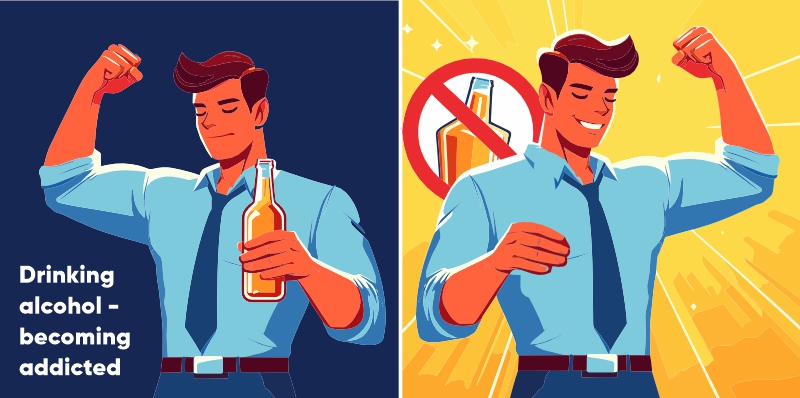Drinking alcohol – becoming addicted

The phenomenon of alcohol consumption, like no other, permeates all spheres of human existence and has a great impact on the state of health, destroying the brain and other human organs. This phenomenon is supported both by physiological dependence and by social conditions, genetic predisposition and centuries of tradition.
Alcohol has been man’s “faithful companion” since time immemorial. Strange as it may seem, the use of ethyl alcohol has considerable benefits for the body: it reduces fear, anxiety and nervous tension, promotes physical and mental relaxation, creates a good mood, improves appetite, etc. In addition, dry wines, for example, “thin” the blood, preventing the formation of plaques and blood clots, which are the cause of blood vessel blockage in heart attacks and strokes. But it is relevant in the context of rational drinking, refined gourmetism.
There are no fixed norms for alcohol consumption, it is purely individual. Of great importance are established centuries-old traditions, social status, age, health, intellectual and moral level, individual psycho-emotional characteristics of personality. Annual per capita consumption of alcohol in Russia is 14-16 litres of pure ethyl alcohol. Not everyone is able to define a specific limit beyond which alcohol consumption becomes an integral part of their life.
The harmful habit of drinking gradually develops into addiction. As a result of the systematic use of alcohol, a complex of symptoms of painful addiction develops: there is a loss of the sense of proportion and control over the amount consumed, the activity of the central and peripheral nervous system is disturbed (psychosis, neuritis, etc.), a withdrawal syndrome develops.
The withdrawal syndrome (hangover) develops gradually, against the background of uncontrollable craving for alcohol (or drugs), there is excitement, trembling hands, restlessness, anxiety or fear, often replaced by longing. The functions of all bodily systems are disturbed, blood pressure rises, heart rate increases, characterised by motor restlessness alternating with severe weakness.
As alcohol addiction develops, there is a deep exhaustion of the body, the tolerance to alcohol decreases – gradually a person gets drunk from very small doses. With the intensification of uncontrollable cravings, the morning hangover turns into daytime drunkenness. In order to alleviate the physical and mental discomfort, the drinker needs to “treat” the hangover, which is the same as being “sick”. Two main criteria reliably confirm the presence of developed alcoholism – loss of control over the amount drunk and hangover syndrome.
The alcoholic’s brain can no longer function without alcohol, and the liver is unable to process it. To understand how addiction develops, consider the entire path of alcohol in the body.
Absorbed in the stomach and intestines, alcohol enters the bloodstream. The blood carries the alcohol to the liver. For the liver, it is a foreign substance, so the appropriate response to its invasion begins: the liver produces a special enzyme, alcohol dehydrogenase, which breaks down ethyl alcohol into its constituent parts. One of these components is acetaldehyde – a powerful poison, many times more toxic than the alcohol itself. It is this poison that causes intoxication of the body, vomiting, headache, incoordination and later – withdrawal syndrome. Acetaldehyde has the ability to interact with various structures of the body, resulting in their damage and disruption of normal functioning.

